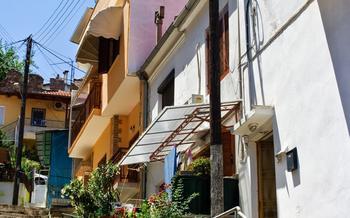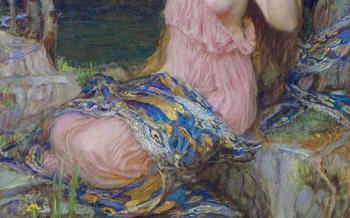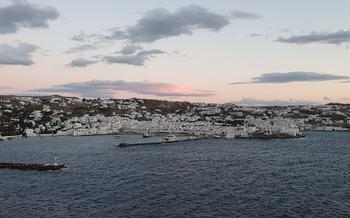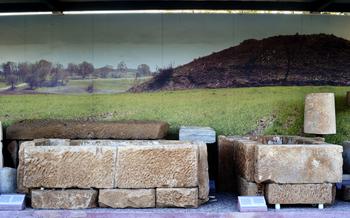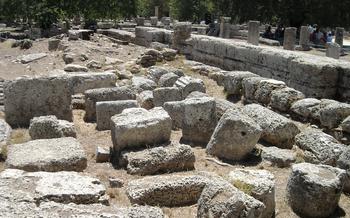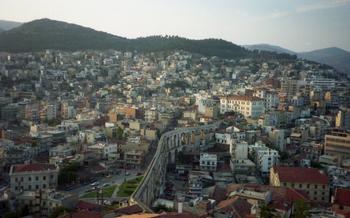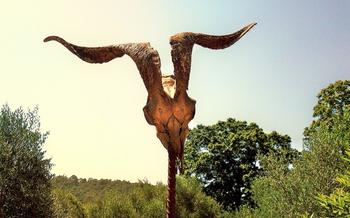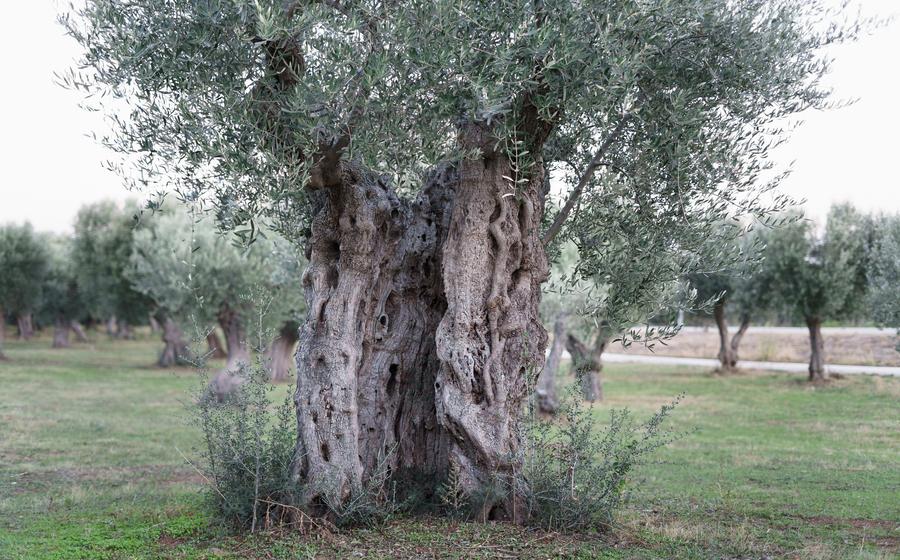
Makri Archaeological Site
- The Ancient City of Maroneia
- The Walls of Maroneia: A Testament to Resilience
- The Theater of Maroneia
- The Temples of Maroneia
- The Agora of Maroneia: A Thriving Marketplace and Social Hub
- The Necropolis of Maroneia: A Journey Through the Afterlife
- The Museum of Maroneia
- Local Cuisine and Dining
- Nearby Attractions and Excursions
- Festivals and Events
- Accommodation and Where to Stay
- Transportation and Getting Around
- Insider Tip:
- Insider Tip: A Hidden Gem Revealed
The Ancient City of Maroneia
The ancient city of Maroneia, nestled within the Makri Archaeological Site, holds a significant place in Greek history. Founded in the 7th century BC by colonists from the island of Chios, Maroneia flourished as a prosperous trading hub and a cultural center in the region. Its strategic location on the Aegean coast allowed for easy access to maritime routes, facilitating trade and cultural exchange.
During its heyday, Maroneia was adorned with impressive structures that showcased the city's wealth and cultural achievements. The well-preserved ruins of a magnificent theater, capable of accommodating thousands of spectators, stand as a testament to the city's vibrant cultural life. Numerous temples dedicated to various deities, including Apollo, Dionysus, and Artemis, reflect the deep religious beliefs of the ancient Maronians.
In my conversation with a local historian, I gained fascinating insights into the daily lives of the ancient Maronians. He described a bustling city, where merchants from far and wide converged to trade goods, ideas, and stories. The streets echoed with the sounds of lively markets, where farmers sold their produce, artisans displayed their crafts, and merchants haggled over prices. The city's prosperity also attracted scholars, philosophers, and artists, who contributed to Maroneia's reputation as a center of learning and culture.
The Walls of Maroneia: A Testament to Resilience
The city walls of Maroneia stand as a testament to the resilience and ingenuity of its ancient inhabitants. Constructed in the 4th century BC, these fortifications were designed to protect the city from invaders and secure its strategic position on the Aegean coast. The walls were built using large blocks of stone, carefully fitted together without mortar. They feature towers and gates, as well as a sophisticated system of ramparts and moats.
Walking along the ancient ramparts at dusk, one can't help but feel a sense of awe and wonder. The walls have stood for centuries, silently bearing witness to the rise and fall of civilizations. They have protected the city from countless threats, from marauding armies to barbarian hordes. Today, they stand as a reminder of the enduring strength and resilience of the human spirit.
In the fading light of day, the walls cast long shadows across the landscape, creating an eerie and atmospheric ambiance. One can almost imagine the ghostly figures of ancient soldiers patrolling the ramparts, keeping watch over their beloved city. It's a haunting and evocative experience that transports visitors back in time to a world long past.
The Theater of Maroneia
The ancient theater of Maroneia is an impressive sight, showcasing the city's cultural significance. Constructed in the 4th century BC, the theater boasts a remarkable state of preservation, allowing visitors to imagine the vibrant performances that once graced its stage. With a seating capacity of over 5,000 spectators, the theater served as a venue for theatrical productions, musical concerts, and civic assemblies.
The theater's architectural features are a testament to the skill of ancient Greek builders. The orchestra, or central performance space, is surrounded by concentric rows of stone seats, providing an excellent view of the stage from all angles. The stage itself is adorned with intricate carvings and sculptures, hinting at the elaborate sets and costumes used in ancient performances.
A visit to the theater is a journey back in time, allowing visitors to experience the cultural richness of ancient Maroneia. Imagine the roar of the crowd as a talented actor delivers a powerful monologue, or the melodious strains of a flute accompanying a chorus of singers. The theater's acoustics are remarkably well-preserved, ensuring that every word and note carries clearly throughout the auditorium.
Anecdote:
During my visit to the theater, I had the privilege of witnessing a mesmerizing performance of Sophocles' "Oedipus Rex." The tragedy unfolded before my eyes, as the actors brought the ancient characters to life with passion and intensity. The audience was captivated by the timeless tale of fate and free will, and the theater seemed to reverberate with the emotions of the characters. It was a truly unforgettable experience, transporting me back to the days when Maroneia was a thriving cultural center.
The Temples of Maroneia
The ancient city of Maroneia was home to several temples dedicated to various deities. The most prominent of these temples is the Temple of Apollo, which was constructed in the 6th century BC. This Doric-style temple features a well-preserved cella and a row of columns supporting a triangular pediment.
Another significant temple in Maroneia is the Temple of Artemis, which was built in the 5th century BC. This temple is dedicated to the goddess Artemis, the protector of women and childbirth. It features an Ionic-style facade and a cella that once housed a cult statue of the goddess.
Other temples found within the city include the Temple of Athena, the Temple of Dionysus, and the Temple of Asclepius. These temples varied in size and architectural style, reflecting the diverse religious beliefs and practices of the ancient Maronians.
Each temple served as a center of religious devotion and ritual activity. Citizens of Maroneia would gather at these temples to offer prayers, make sacrifices, and celebrate religious festivals. The temples also played a significant role in the political and social life of the city, as they were often used for official ceremonies and public gatherings.
The Agora of Maroneia: A Thriving Marketplace and Social Hub
The agora of Maroneia was a bustling center of commerce and social interaction in ancient times. Located at the heart of the city, it served as a marketplace, a meeting place, and a venue for public gatherings. The agora was a large open space surrounded by stoas, or covered walkways, which housed shops and workshops. These shops sold a variety of goods, including food, clothing, pottery, and tools.
In addition to its economic function, the agora was also a place where people came to socialize and exchange news. It was here that citizens gathered to discuss politics, listen to speeches, and celebrate religious festivals. The agora was also the site of the city's law courts and other administrative buildings.
Anecdote:
As I strolled through the agora, I couldn't help but imagine the lively atmosphere that must have filled this space centuries ago. I could almost hear the voices of merchants hawking their wares, the laughter of children playing, and the debates of philosophers discussing the latest ideas. It was easy to see why the agora was the heart and soul of ancient Maroneia.
The Necropolis of Maroneia: A Journey Through the Afterlife
The necropolis of Maroneia, an ancient cemetery located just outside the city walls, offers a glimpse into the burial practices and beliefs of the ancient Maronians. Here, visitors can explore a variety of tombs, ranging from simple pit graves to elaborate chamber tombs, each providing insights into the social stratification and funerary customs of the city's inhabitants.
The necropolis is a treasure trove of information for archaeologists and historians, as it has yielded a wealth of artifacts, including pottery, jewelry, and coins, which shed light on the daily lives and beliefs of the Maronians. These artifacts provide clues about their religious practices, social status, and economic activities.
Anecdote: Exploring the necropolis at night was an eerie yet fascinating experience. As I walked among the ancient tombs, the moonlight casting long shadows across the landscape, I couldn't help but feel a sense of connection with the departed souls who once called Maroneia home. It was a reminder that even in death, the past is never truly forgotten.
The Museum of Maroneia
The Museum of Maroneia is a treasure trove of artifacts that tell the story of the ancient city and the surrounding region. Located in the heart of Makri, the museum houses a diverse collection of exhibits that shed light on the rich history and culture of Maroneia.
As you step inside the museum, you are greeted by an impressive display of pottery from various periods, including the Neolithic, Bronze Age, and Hellenistic eras. The delicate shapes and intricate decorations of these vessels offer a glimpse into the artistic prowess of the ancient Maronians.
Among the highlights of the museum's collection are the sculptures, which range from small figurines to larger-than-life statues. These works of art depict gods, goddesses, heroes, and everyday people, providing a fascinating glimpse into the religious beliefs and daily lives of the ancient inhabitants.
Of particular interest are the inscriptions found in Maroneia. These stone tablets and fragments bear inscriptions in Greek and Latin, offering valuable insights into the city's history, laws, and administration. They provide a tangible connection to the past, allowing visitors to read the words of the ancient Maronians themselves.
The Museum of Maroneia is not just a repository of artifacts; it is a place where history comes alive. Through its exhibits, the museum tells the story of a vibrant and prosperous city that played a significant role in the ancient world. It is a must-visit for anyone interested in exploring the rich cultural heritage of Maroneia.
Anecdote:
During my visit to the Museum of Maroneia, I had the thrill of discovering a rare coin in the museum's collection. As I was examining a display of coins from the Hellenistic period, I noticed a small, silver coin that stood out from the rest. It was worn and tarnished, but the intricate design on its surface was still visible.
I called over a museum attendant, who confirmed that the coin was indeed a rare find. It was a tetradrachm, minted in Maroneia during the reign of Alexander the Great. The attendant explained that the coin was likely used for trade or as a form of currency in the ancient city.
Holding that ancient coin in my hand, I felt a connection to the past. It was a tangible reminder of the rich history and culture of Maroneia, and a treasure that had survived the passage of time.
Local Cuisine and Dining
The culinary delights of Makri and the surrounding region are a blend of traditional Greek and Turkish flavors, reflecting the area's rich cultural heritage. Visitors can indulge in a variety of mouthwatering dishes, from fresh seafood to succulent grilled meats and homemade pastries.
-
Must-Try Dishes:
-
Grilled Octopus: Tender octopus grilled to perfection and served with a drizzle of olive oil and lemon.
-
Moussaka: A classic Greek dish made with layers of eggplant, potatoes, ground beef, and a creamy béchamel sauce.
-
Baklava: Layers of filo pastry filled with chopped nuts and sweetened with honey syrup.
-
Local Restaurants and Tavernas:
-
To Steki tou Ilia: A family-run taverna serving traditional Greek cuisine in a cozy atmosphere.
-
O Hamos: A popular spot for fresh seafood, with tables overlooking the picturesque harbor.
-
To Spitiko: A hidden gem known for its homemade pastries and desserts.
-
Anecdote:
During my visit to Makri, I had the pleasure of dining at a family-run taverna nestled in the heart of the old town. The aromas wafting from the kitchen were irresistible, and I couldn't resist ordering the grilled octopus. As I savored each tender bite, I couldn't help but feel grateful for the opportunity to experience the authentic flavors of this culinary paradise.
Nearby Attractions and Excursions
Beyond the captivating ruins of Makri, the surrounding region offers a treasure trove of additional historical sites and natural wonders waiting to be explored. Just a short drive away, the vibrant city of Alexandroupoli beckons with its bustling harbor, charming Old Town, and lively nightlife. For those seeking a tranquil escape, the verdant isle of Samothraki, with its pristine beaches, lush forests, and mystical waterfalls, is an idyllic retreat.
Nature enthusiasts will delight in the opportunity to embark on a scenic hike through the Dadia Forest, a haven for birdwatchers and wildlife enthusiasts. This enchanting woodland is home to a diverse array of bird species, including majestic eagles and colorful woodpeckers, as well as a variety of other flora and fauna. Whether you prefer to wander along the well-marked trails or venture off the beaten path, the Dadia Forest promises an unforgettable adventure.
For a truly immersive cultural experience, visitors can delve into the rich traditions of the region by attending one of the many festivals and events held throughout the year. The Maroneia Wine Festival, a celebration of the local viticulture, offers a chance to sample delicious wines, savor traditional delicacies, and witness lively performances. The Samothraki Festival of Ancient Drama, held in the atmospheric ruins of the island's ancient theater, transports visitors back in time with captivating performances of classical Greek plays.
These are just a few of the many treasures that await in the vicinity of Makri. With its wealth of historical sites, natural wonders, and cultural events, the region offers something for every traveler. Whether you seek history, adventure, or simply a relaxing escape, you are sure to find it here.
Festivals and Events
Makri and its surroundings come alive during the summer months with a vibrant calendar of cultural festivals and events that showcase the region's rich heritage and traditions. One of the highlights is the annual Maroneia Festival, held in July or August, which celebrates the ancient city's history and culture through traditional music, dance, and theater performances.
Another popular event is the Samothrace Festival, held on the neighboring island of Samothraki, which features a variety of artistic and cultural activities, including concerts, exhibitions, and workshops. For a truly immersive experience, visitors can join the Wine Festival held in the nearby village of Echinos, where they can sample local wines and delicacies while enjoying live music and traditional dancing.
These festivals offer a fantastic opportunity to connect with the local community, learn about their customs, and create lasting memories.
Accommodation and Where to Stay
Makri offers a range of accommodation options to suit every traveler's needs and budget. For a comfortable and convenient stay, consider the Makri Beach Hotel, located right on the waterfront with stunning views of the Aegean Sea. The hotel features modern rooms and suites, a swimming pool, and a restaurant serving delicious Greek and international cuisine.
For a more budget-friendly option, the Maronia Guesthouse is a charming family-run establishment offering cozy rooms and a warm atmosphere. The guesthouse is situated in the heart of the old town, within easy walking distance of all the major attractions.
If you're looking for a truly unique experience, consider staying at the Dadia Forest Resort, located in the nearby Dadia Forest National Park. The resort offers eco-friendly cabins and treehouses nestled amidst the lush forest, providing guests with a chance to immerse themselves in nature.
To find the best deals on accommodation, it's advisable to book in advance, especially during the peak tourist season. Online booking platforms and travel agents can help you compare prices and availability across different hotels and guesthouses.
Anecdote:
During my last visit to Makri, I had the pleasure of staying at a charming boutique hotel called the "Aegean Breeze." The hotel was located on a hilltop overlooking the town, offering breathtaking views of the Aegean Sea. The rooms were tastefully decorated with traditional Greek elements, and the staff was incredibly friendly and helpful. I particularly enjoyed the hotel's rooftop terrace, where I could relax with a glass of wine and watch the sunset over the sea.
Transportation and Getting Around
Makri is well-connected by public transportation, with regular buses and trains running to and from the city of Alexandroupoli. The bus station is conveniently located near the center of Makri, making it easy to catch a bus to explore the surrounding area. Train services are also available, with the nearest train station being in Alexandroupoli. If you're looking for more flexibility, renting a car is a great option. Several car rental agencies are located in Makri, allowing you to pick up a car right at the airport or in the city center.
Insider Tip:
For a truly unique experience, consider renting a bicycle and exploring the scenic countryside surrounding Makri. The region is home to a network of well-maintained bike paths, taking you through picturesque villages, rolling hills, and stunning coastal landscapes. Whether you're an experienced cyclist or just looking for a leisurely ride, biking is a fantastic way to soak in the beauty of the region and discover hidden gems along the way.
Insider Tip: A Hidden Gem Revealed
Beyond the well-trodden paths of Makri, a hidden gem awaits those who seek tranquility and unspoiled beauty. Nestled amidst a grove of olive trees, just a short walk from the bustling city center, lies a secluded beach that seems to have been untouched by time. With its crystal-clear waters, soft golden sands, and breathtaking views of the Aegean Sea, this secret spot offers a sanctuary for those seeking respite from the crowds.
Whether you prefer to bask in the warm Mediterranean sun, take a refreshing dip in the azure waters, or simply relax and soak in the tranquil atmosphere, this hidden beach is the perfect place to escape the hustle and bustle of everyday life. As you lie on the sand, the gentle sound of the waves and the rustling of the olive leaves create a soothing symphony that lulls you into a state of serenity.
To reach this hidden gem, follow the path that leads from the main road into the olive grove. As you approach the beach, the air becomes infused with the heady scent of jasmine and pine, creating an intoxicating aroma that adds to the magical ambiance of this special place.
So, if you're looking for an authentic and unforgettable experience in Makri, be sure to seek out this hidden gem. Embrace the tranquility, indulge in the beauty, and create memories that will last a lifetime.

